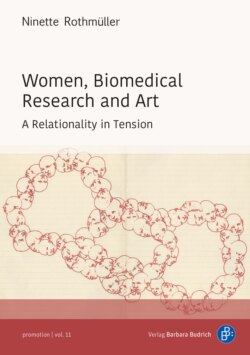Women, Biomedical Research and Art

Реклама. ООО «ЛитРес», ИНН: 7719571260.
Оглавление
Ninette Rothmüller. Women, Biomedical Research and Art
promotion 11
Table of Contents
[9] Acknowledgments
[10] 1 Prologue
1.1 Introduction
1.1.1 Research Leading to this Study
[19] 1.1.2 Embedding the Research in Pedagogy
1.1.3 Content of Chapters
[31] 2 On the Matrix of this Study OR How to Soar
[36] 2.1 On the Interest in Messiness and Inclusion
[39] 2.2 Body/Körper and Leib – an Attempt to Define Relationality through Translation, Time, and Meaning
[40] 2.2.1 An Introduction to Spaces of Public Reflections: On Erasing and Connecting “Semi-real” Bodies
2.2.2 On the Interface of Body/Körper and Leib – the Significance of Translations and Relationality between Experience and Language
2.3 Body/Körper and Leib – Historical Connections – Philosophical and Religious Framings
[54] 2.3.1 On the Interface of Body, Leib and Körper – Phenomenology and Post- structural Thoughts
2.4 Body/Körper and Leib – Theory and its Application
[59] 2.4.1 On the Entwinement of Body/Körper and Leib
2.5 Leib Confrontations
[64] 3 The Methodological Conceptualization of the Project
[68] 3.1 The Pre-study
3.2 The Multi-Sited Characteristics of this Study
3.2.1 Germany and the UK as Geographical, Political, Legal, Social, and Cultural Research Sites
3.2.2 Sites of Technological Intersections
3.2.3 Sites of Transdisciplinarity
3.3 Fieldwork
3.3.1 Feminist Ways of Knowing
3.3.2 Locating Visuals in the Field and Social Science Research
3.3.3 Carrying out Conversations
3.3.4 On the Shift to Talking of Conversations instead of Interviews and on the Role of Both Conversation Partners
[97] 3.3.5 Incorporating Texts in Fieldwork
3.4 Analysis/Writing
[98] 3.4.1 Transcription and Authorization
3.4.2 On the Use of Language as an Analytical Tool
3.4.3 Art as a Tool to Research – Of Women
[110] 4 Fragmentations
4.1 Entities in a Chapter about Fragmentation
4.2 Constructing Potential Things in Time and Space
[116] 4.2.1 Telling the Story – Presenting the Pictures. On Trying to Grasp what is at Stake
[126] 4.2.2 Telling the Story – Sensing Women. Contributions to Confusion
4.2.3 Presenting the Picture – Sensing the Female Body. Contributions in Search of Matter(s)
4.2.4 Preparing the Stage – On Spaces of Separation and Hierarchies
4.2.5 Seeking Company – Speaking, Writing, Seeing
[140] 4.3 Bodies at Stake – Visualized, Seduced, Taken Apart, but Alive?
[142] 4.3.1 Bodies Inside out – Dwelled Space Seduced
[151] 4.3.2 The Heartbeat of a Machine and I
4.3.3 On the Organic Colonization of Scotland and England by a Pregnant Woman
4.4 Final Thoughts
[159] 5 Body Geographics. Territories, Trades, and Mappings in Inequality
[160] 5.1 Body Territories Under Re-construction – an Introduction
5.1.1 Body Territories Under Re-construction – Voices
[167] 5.1.2 Body Territories Under Re-construction – Actors and Activities
[172] 5.1.3 Bodily Substance Transfer and Hierarchies in Organ Transplantations or, When Are We Dead?
5.1.4 Mapping Sites in Action – On the Creation of Powerful Stories, Marketable Events, and Images
[186] 5.1.5 Art and the Skinned and Scanned Human
[193] 5.2 Traffics in the Body – Historical Remarks on Substantial Trade Relations
[201] 6 Gendered Harvest
6.1 Cells at Stake – Ethical and Legal Approaches
[209] 6.2 Human Recycling – Terms and Conditions
6.2.1 Bodies and Borders – Voices
[217] 6.2.2 Body Exchange and Leib Rejection
6.3 Gendered “Donations”
6.3.1 Rearranging Borders – Organs and Tissue Travel from East to West and from Bottom to Top
6.3.2 Harvesting the Body during the Gold Rush
6.3.3 Gifts and Commodities – Writing Values onto Bodies
6.3.4 Celebrating Christmas during Birth OR How to Be a “Good Citizen”
[249] 7 Participatory Art and Public Engagement
[251] 7.1 To Create
7.1.1 To Create Here and Now, There and Then
7.1.2 Space, Place, Site, Location – Theoretical Considerations
7.2 It’s Best to Take Risks when Nothing is Safe to Start with
7.2.1 Contemporary Social Landscapes of Creation OR Whose Voices Make to Not Create Not an Option
7.3 Biomedical Developments as Sites of Action – Investigating and Creating
7.3.1 Focus Creative Works – Time, Space, Travels
[281] 7.3.2 Stories of Matter – Sites of Action
7.4 To Conclude
[291] 8 Showdown
8.1 Showdown I – Writing on Flesh
8.2 Showdown II – my House
[300] 8.3 Showdown III – the Best
[304] 8.4 Showdown IV – Play it – Make it a Condition and a Task
8.5 Epilogue
[321] Note on Accessibility
[323] References
[369] Index
Notes
Отрывок из книги
The dissertation prize is awarded by Verlag Barbara Budrich
Members of the jury of experts:
.....
8.4 Showdown IV – Play it – Make it a Condition and a Task
8.5 Epilogue
.....